nice to meet you.
This is Yamanaka from the creative department.
This time I would like to introduce Mouko Tanmen Nakamoto, my absolute favorite.
As many of you may already know, this is a ramen chain restaurant that serves extremely spicy ramen, claiming to be the spiciest and tastiest in Japan.
The closest store to the office is the Shinjuku store, which is a 20-minute walk from Monosus, and a 40-minute round trip. Sometimes I gather friends and go by taxi. Nakamoto has something so appealing about it that it's worth the effort.
The Road to Nakamoto
The first time I tried Nakamoto, it was in a cup ramen sold at 7-Eleven. (Mōko Tanmen can only be purchased at 7-Eleven or through Ito-Yokado's online store.)
I've always loved spicy food and was always looking for something even spicier, so I remember being attracted to Mongol Tanmen by its spicy-looking packaging and giving it a try.

Cup ramen piled high in convenience stores. Its presence is sure to catch your eye.
My first impression after eating it was, "It's pretty good."
I'm sorry if this sounds arrogant, but I was delighted by how delicious and spicy it was, beyond my expectations.
After that, I continued to eat cup ramen regularly, and then Mouko Tanmen Nakamoto added a new type of cup ramen called "Hokkyoku" to their lineup.
Both "Mōko Tanmen" and "Hokkyoku" are standard menu items available at physical stores, but I heard that Hokkyoku is much spicier than Mōko Tanmen, in that it is extremely spicy.
Filled with anticipation, the moment I first drank the soup from Hokkyoku Cup Ramen,
"Spicy and delicious! This is amazing!"
This is clearly different from any super spicy food I've had before, what on earth is this?!
With these thoughts in mind, I ate with gusto, and before I knew it, I had drunk all the soup.
And the moment I finished eating, I felt truly grateful.
I've never tasted anything so spicy and delicious before. Thank you for making something so delicious! That's what I honestly thought.
From then on, I continued to buy boxes of Hokkyoku, eat them, and end up with diarrhea.
For some reason, I was satisfied with the cup ramen and didn't go to the store, but finally, I was ready to go and try it out.
Since it was my first time there, I ordered their signature dish, Mouko Tanmen.
It definitely had a different flavor to cup ramen, with a rich taste and umami flavor, and I remember being comforted by how delicious it was.
However, being used to Hokkyoku cup ramen, I found it not spicy enough for me, and this made me resolve to try the real Hokkyoku ramen sometime soon.
However, I couldn't shake the worry that the real Hokkyoku Ramen would be spicier than the cup ramen and I wouldn't be able to finish it, so I repeated the process of eating the Mongol Tanmen several times and then peeking at the reactions of the customers eating Hokkyoku.
Finally, I took the plunge and ordered the Hokkyoku Ramen. When the Hokkyoku ramen was brought to me, the soup was thick with chili powder, quietly exuding an aura of spiciness.
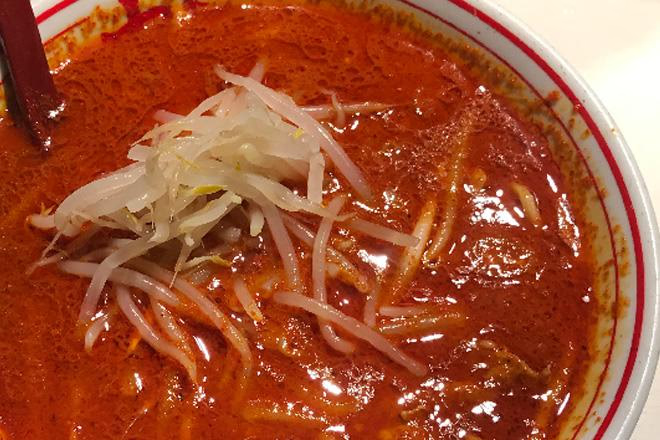
The Hokkyoku Ramen comes with 1.5 servings of noodles, so you can adjust the amount by asking for "less noodles" or "half noodles" when ordering. The photo shows "half noodles," and the price remains the same at 830 yen.
Then take a sip of the soup.
"Hmm? It's not spicy."
After drinking two or three more mouthfuls of soup, I thought, "It's not spicy, it's actually sweet!"
That's right. Hokkyoku isn't just spicy, but it also has an incredible umami flavor beyond the spiciness.
Once you experience this, it will be extremely difficult to get away from Hokkyoku Ramen.
Afterwards, I continued eating enthusiastically, chanting in my mind: "It's delicious, it's delicious , it's too delicious!"
I didn't think it was very spicy at first, but as I continued to eat it, I honestly felt that rather than it being spicy, my mouth was numb and I couldn't really tell if it was spicy or hot.
However, the endless sweat was all that was flowing, telling of their struggle against the North Pole.
The moment I finished eating after such a frantic fight, I felt a sense of fatigue and accomplishment, sweat that wouldn't stop, and numb lips. I didn't really know what was going on, but I felt a sense of relief that I was able to finish it all. It was a debut match filled with many different emotions.

No matter how spicy it is, eat it all. That's my respect for Nakamoto...
From then on, I continued to eat Hokkyoku regularly, craving something spicy.
Being an extreme person, I have had the repeated experience of eating as much of the things I like as I wanted, only to end up getting tired of them and hating them (at Nakamoto this is called "altitude sickness." From the Mouko Tanmen Nakamoto fan site ), so I didn't want to make the same mistake at Nakamoto, and I was searching for the best distance to keep from Nakamoto. And so I came up with the current pace of once a week.
I really want to eat more, but I'm holding back and looking forward to going once a week.
This has become a long story, but that is how my relationship with Nakamoto was formed.
Then in April 2016, he joined Monosus.
Soon after I joined the company, I changed the Chatwork icon I used for work to Hokkyoku Ramen, which led to people who loved Nakamoto saying, "Let's go to Nakamoto," and we all started going to the Nakamoto store in Shinjuku.
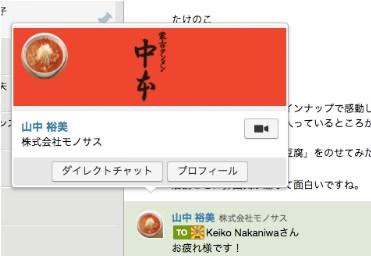
I use my favorite Mongolian tanmen as my Chatwork icon.
I had just joined Monosus and didn't know much about it yet, but the fact that I would have many friends who were willing to accompany me to Nakamoto made me think right away, "I'm glad I joined this company" (laughs).
How to enjoy Nakamoto
With all this information about how hot it is, people who don't like spicy food tend to steer away from it, but Nakamoto also has "non-spicy menus" that are not spicy. And they are delicious too!
Nakamoto doesn't just sell itself on being super spicy; the ramen itself is delicious.
Here, I would like to introduce my own way of enjoying Nakamoto to those who are new to the place.
For those who don't like spicy food, we definitely recommend the Shio Tanmen. It is the only menu item at Nakamoto that is not spicy at all.
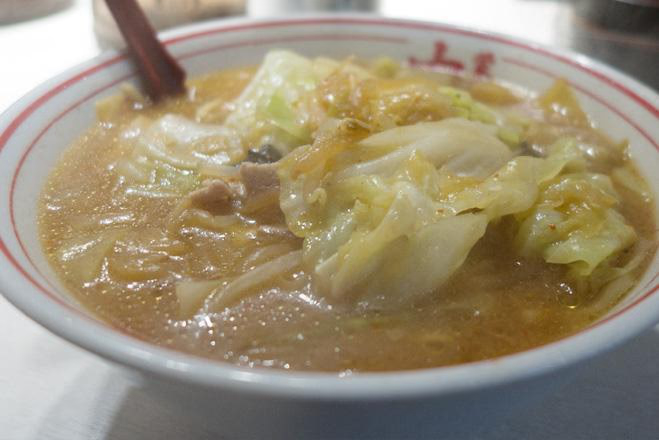
Salt tanmen, 0 spiciness, 750 yen. This is the only lightly salted dish on the Nakamoto menu, which is mostly miso-based.
Next, if you think you can handle spicy food, try the signature dish, "Mongolian Tanmen."
The base is miso tanmen, topped with mapo tofu and vegetables. The spiciness of the mapo and the sweetness of the vegetables are perfectly matched, and you will be captivated with every bite.
Also, after getting used to the spiciness with a "Mōko Tanmen" cup ramen, trying the real thing is also very enjoyable.
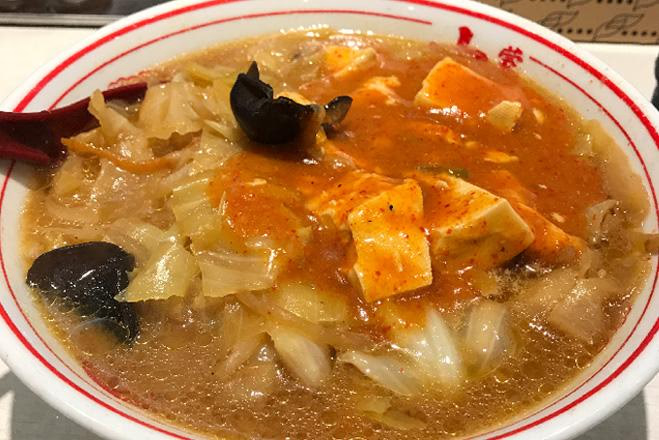
Mongolian Tanmen, spiciness level 5, 800 yen. Miso tanmen topped with mapo tofu, a popular staple menu item at Nakamoto.
If you are not sure how spicy Mōko Tanmen is, we recommend the Miso Tanmen. The Mōko Tanmen is rated at 5, while the Miso Tanmen is rated at 2, so it's perfect for those who don't like spicy food but would still like to try it.
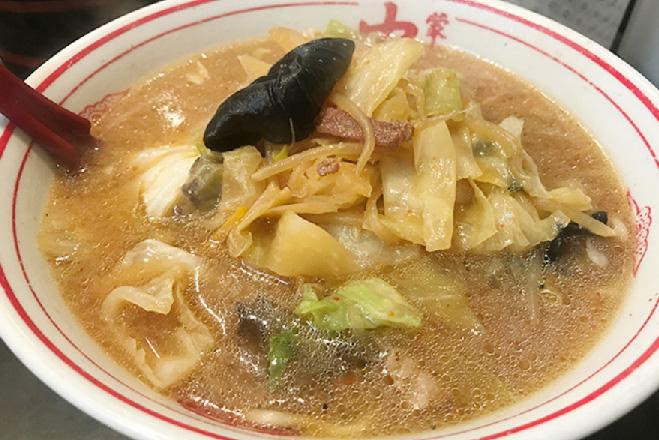
Miso tanmen, spiciness level 2, 780 yen. Recommended for those who are not used to spicy food.
And for those who want to try "Hokkyoku Ramen," we strongly recommend that you refrain from taking on a reckless challenge and instead train yourself to a certain extent before attempting it.
As it was for me, trying "Hokkyoku Ramen" for the first time is not just an act of eating ramen, but a kind of "battle." If you eat it for fun or on impulse, you will be completely defeated. One of our company's Mr. I was one of those people. He always ate "Mōko Tanmen," but one day he suddenly ordered "Hokkyoku Ramen," and ended up being completely defeated, as you can see in the photo.

Arctic Ramen, before and after
Now, I would like to share with you my personal journey to eating all the Hokkyoku Ramen.
The simple answer is to eat the same menu several times and then increase the spiciness level as you get used to it.
"Mongolian Tanmen (spiciness level 5)" → "Gomoku Mongolian Tanmen (spiciness level 6)" → "Miso egg noodles (spiciness level 8)" → "Hokkyoku Ramen (spiciness level 9)"

The menu lists the spiciness levels, so you can work your way up.
If you can handle a lot of spiciness, you can step up to a higher level all at once, but as a sign of our utmost respect for Nakamoto, we ask that you choose a level of spiciness that you can eat without leaving any behind.
So, here are some things to keep in mind when the time finally comes to eat Hokkyoku Ramen.
"Don't slurp the noodles, carry them!"
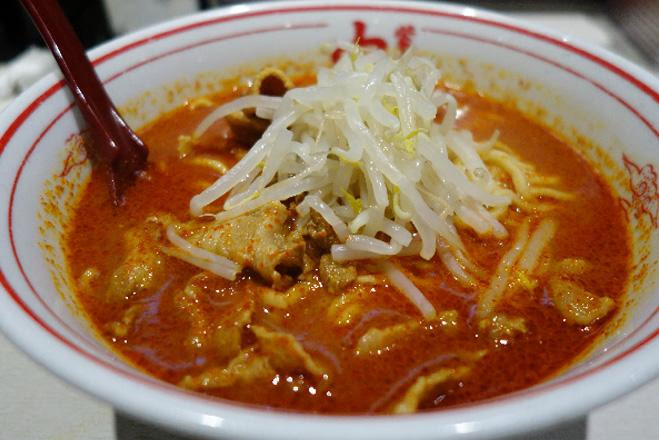
Although it is a simple dish consisting of just soup, noodles, bean sprouts and pork belly, the spiciness and flavor are exquisite.
As you can see from the picture, it contains a lot of chili powder. Just like regular ramen, if you slurp it vigorously, the chili powder will attack your throat mercilessly. You will choke. You will cry. You may even lose by default.
First, put a small amount of noodles onto the spoon, then use your chopsticks and tongue to bring the noodles into your mouth. Then, enjoy the taste. That's it.
Also, at first, after eating a few bites, the spiciness numbs the inside of your mouth. So, you need to be careful of burns. There have been a few times when I didn't notice it at the time, but after a while I finished eating, I found that the inside of my mouth had been burned.
Putting it this way may make it seem like a very dangerous food, but in my case, I think it was because it was so spicy that I was afraid that if I took even a short break, I wouldn't be able to finish it, so I ate it in a hurry. If you continue eating while blowing on it, there's no problem, but the first time you eat it, it's easy to lose your cool.
Also keep in mind the "enough hoo-hoo" point.
And finally, just to be on the safe side, Saturday is probably the best day to try Hokkyoku Ramen for the first time.
I won't go into details, but that's it, it is a "battle" in many senses.
Nakamoto Culture
Another fun thing to enjoy at Nakamoto is the merchandise.
You can earn 1 point for every 500 yen you spend and exchange them for Nakamoto merchandise.
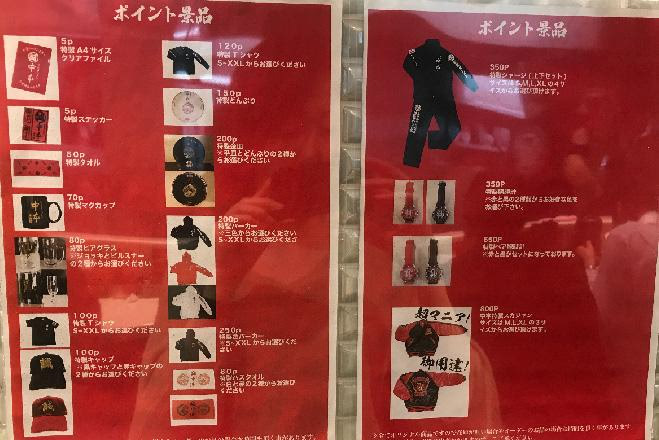
You can tell how much of a Nakamoto fan you are by what you own.
There is a truly wide lineup, and I go there eagerly to collect points. I have now acquired clear files, stickers, mugs, and bath towels, creating an environment where I can concentrate on my work.

I am surrounded by Nakamoto goods and working hard.
Additionally, the bags that the merchandise comes in (see image on the right) are also original, and although it may sound rude considering the amount of merchandise, they are all of very high quality.
The points are valid at all stores and have no expiration date, which is a great thing to admire.
Not only is the ramen at Nakamoto delicious, the service is also very friendly, which is probably one of the reasons why people are willing to wait in line to eat there.
The other day, as the ramen for the customer sitting next to me was brought to me, I quickly handed him a glass and said, "This is water without ice, for you to take your medicine."
I glanced over and saw that the customer had some medicine on his table.
"Nakamoto, you've gone to such lengths?" To be honest, I was surprised.
Even though the restaurant was full and he had to handle orders one after another, he noticed one customer was taking medication and casually offered him a glass of water without ice, which was admirable.
I vowed to continue eating at Nakamoto, which captivates fans not only with the taste of its ramen, but also with its customer service and merchandise.
Nakamoto's ripple effect
Since joining Monosus, I have been going to Nakamoto whenever I have free time, recruiting friends, and more and more people are becoming addicted to Nakamoto.
We have also sent cup ramen to the Kamiyama satellite office where the operations team members work, and as expected, many people have become addicted to it. There is no 7-Eleven near the office, so they have to go to the 7-Eleven in Tokushima City to buy it, but some members even go to the city to buy Mouko Tanmen.
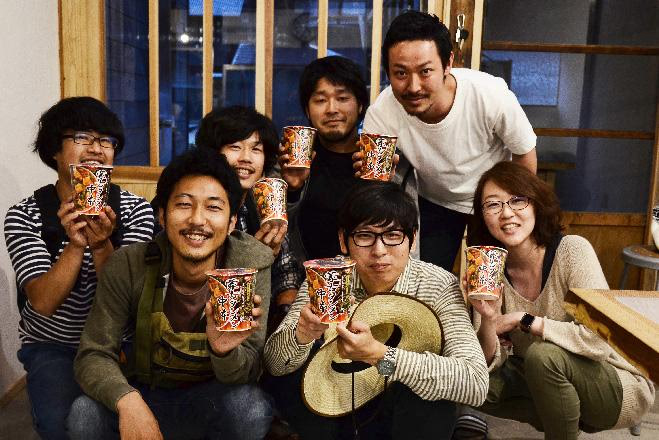
A commemorative photo with a bowl of Mouko Tanmen that I brought with me when I went to Kamiyama the other day.
The editor-in-chief of our Monosasu website is also one of those who has quickly become addicted. On days when he can't eat at the actual store, he expands the ways he enjoys Nakamoto by making his own cup ramen at home.
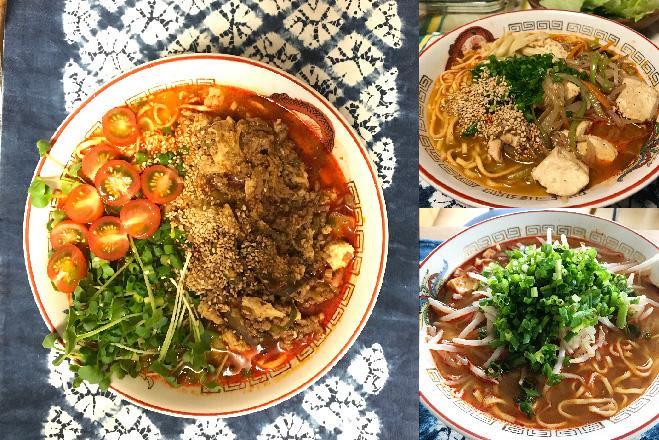
On the left is a dish topped with tomatoes and "Chen Mapo Tofu", on the top right is a dish of tofu and stir-fried vegetables topped with plenty of sesame seeds, and on the bottom right is a dish topped with bean sprouts and green onions.
There are many ways to enjoy it, but what is most invaluable to me is that through Nakamoto I have had more opportunities to talk with people from different departments and people I would not have had the chance to meet at work.
It would not be an exaggeration to say that Nakamoto has enriched my life.
So why not give Nakamoto a visit?
Mouko Tanmen Nakamoto Shinjuku branch
Tokyo, Shinjuku-ku, Nishi-Shinjuku 7-8-11 Mikasa Building B1F
11:00~24:00
No fixed closing days
Tel: 03-3363-3321
http://www.moukotanmen-nakamoto.com/

